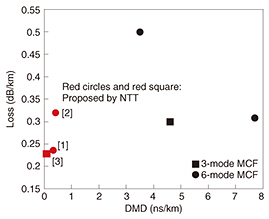 |
|||||||||||||||||||||||||||||||||||
|
|
|||||||||||||||||||||||||||||||||||
|
Feature Articles: State-of-the-art Space Division Multiplexing Technologies for Future High-capacity Optical Transport Networks Vol. 15, No. 6, pp. 29–35, June 2017. https://doi.org/10.53829/ntr201706fa5 Research and Development of Next Generation Optical Fiber Using Multiple Spatial ChannelsAbstractThe capacity of conventional single-mode fiber (SMF) that is widely used in the existing optical communication network is expected to be limited to around 100 Tbit/s. Therefore, next generation optical fiber such as multi-core and/or multi-mode fiber has been investigated in order to overcome the limited capacity of SMF and to utilize multiple spatial channels to realize space division multiplexing (SDM). We introduce in this article the recent progress achieved in SDM fiber. Keywords: optical fiber, space division multiplexing, multi-mode multi-core 1. IntroductionThe capacity of conventional single-mode fiber (SMF) is expected to be around 100 Tbit/s, and therefore, next generation optical fiber that can accommodate traffic at more than 100 Tbit/s is needed for future optical communications systems. Optical communications systems have been developed in line with the low loss and wideband characteristics of SMF and the evolution of transmission technology. Network capacity has greatly increased because of wavelength division multiplexing (WDM) technology, which can transmit multiple signals with different wavelengths in an optical fiber. Digital coherent transmission using a multi-level modulation format has recently been studied as a way to improve spectral efficiency since the operational wavelength window is limited in terms of the loss characteristics of SMF and the amplification bandwidth of erbium-doped fiber amplifiers. Although a very high signal-to-noise ratio is required when a complex modulation format such as quadrature amplitude modulation is used to achieve high spectral efficiency, the input power into the fiber is severely limited by nonlinear effects or the fiber fuse phenomenon. That is why the capacity of SMF is predicted to be limited to around 100 Tbit/s for telecom networks. However, Internet traffic has been increasing at a rate of 30–50% per year, and innovative technology will be required in order to accommodate such a large amount of traffic in the future. One promising solution to this capacity crunch is to use a spatial channel by developing a space division multiplexing (SDM) fiber. In this article, we report the recent progress achieved in SDM fiber as the next generation optical transmission line for ultra-large-capacity systems. 2. Recent research on SDM fiberSDM technology involves the transmission of multiple signals in parallel in the same way as WDM technology. SDM uses spatial channels, for example, by using multiple cores in multi-core fiber (MCF). Generally speaking, parallel transmission using multiple SMFs is also considered to be SDM transmission, but we would like to focus on SDM technology using SDM fiber, where multiple spatial channels exist in an optical fiber. The proposed SDM fiber is illustrated in Fig. 1. SMF has a core in the cross section. In contrast, MCF has multiple cores, and multiple signals can be transmitted through the multiple cores. Multi-mode fiber (MMF) has a relatively larger core than that of SMF, and multiple modes can propagate in this core. Because each propagation mode can be treated as an individual transmission channel, multiple signals can be transmitted through the multiple modes. The parallel transmission scheme using multiple modes is called mode division multiplexing (MDM). Multi-mode MCF, which is MCF with multi-mode cores, has also been investigated as a way to perform MDM transmission in each core [1–5].
The important parameters that should be taken into account when designing SDM fiber are listed as follows.
It is preferable to have as many spatial channels as possible to increase the capacity, and better (or comparable) optical characteristics for each spatial channel than those of SMF are desired in order to achieve higher transmission capacity per spatial channel. In addition to the optical characteristics, mechanical reliability of the fiber is also an important aspect for telecom networks. The failure probability is one factor that affects the mechanical reliability of the fiber. This refers to the probability that the fiber will break if it is stretched or bent. Therefore, the fiber should be properly designed in order to achieve a sustainable network infrastructure. In general, the failure probability increases as the fiber cladding diameter increases. NTT clarified that 250 μm is the maximum cladding diameter to provide mechanical reliability comparable to that of SMF [1] and also investigated the SDM fiber design to maximize the number of spatial channels within the limited cross section of the fiber. NTT defines DSDM (dense space division multiplexing) transmission as the system that can support more than 30 spatial channels [3]. The design considerations for different kinds of SDM fiber and fiber arrangements proposed so far are introduced in the next section. 3. MCF technologyThe relationship between the number of cores and the cladding diameter of the proposed MCFs is shown in Fig. 2. MCF tends to have a larger cladding diameter than that of SMF (125 μm). This is because it requires a larger cross section to deploy more cores. As explained in the previous section, the cladding diameter is limited to a certain value because of the mechanical reliability. Therefore, deploying cores as closely together as possible inside the fiber is effective. However, there is a lower limit of the core pitch in terms of the inter-core crosstalk value, which should be sufficiently low to prevent interference of the transmitted signals.
Cross sections of the proposed MCFs are shown in Fig. 3. Various core arrangements such as hexagonal-lattice [6–8], circular [9, 10], square lattice [11], or a combination of these core arrangements [12, 13] have been proposed. The trench-assisted refractive index structure has been used for each core profile in order to reduce the inter-core crosstalk. The use of a heterogeneous core structure is also considered to be a way to reduce crosstalk. In the heterogeneous MCF design, the index profile of the adjacent core is designed to be different, which can effectively reduce the crosstalk because the propagation constant of the mode in the adjacent core is different. NTT successfully developed a 32-core fiber with a cladding diameter of less than 250 μm by using an MCF design technique that combined a square lattice core arrangement, trench-assisted core profile, and a heterogeneous MCF design. This work was supported by the EU-Japan coordinated research and development (R&D) project known as SAFARI (Scalable And Flexible optical Architecture for Reconfigurable Infrastructure).
Designing MCF with optical properties comparable to those of the SMF is also an important issue. For example, investigations have been carried out on MCF with 125-μm-diameter cladding MCF and with optical characteristics conforming to ITU-T* recommendations on fiber optics in regard to mode field diameter, chromatic dispersion, macrobending loss, and other factors.
4. MMF technologyWe can increase the number of spatial channels by increasing the number of modes per core as well as increasing the number of cores. Reducing the inter-modal crosstalk and differential group delay is also important in the MMF design. However, the propagation modes in multi-mode cores can easily convert to another mode due to structural perturbation in the event of a splice point or fiber bending. Optical multiple-input multiple-output (MIMO) has been proposed to deal with this issue, and signal processing has been investigated in order to compensate for the crosstalk. However, the complexity of signal processing increases as the differential mode delay (DMD) increases. Low DMD fiber has been proposed to reduce the complexity of MIMO processing, and we have investigated trench-assisted graded-index core MMF to reduce the DMD and control the number of propagation modes, as shown in Fig. 4(a) [14]. We successfully adjusted the DMD value by accurately controlling the index profile of the graded core, and we designed the optical properties (e.g., bending loss) of all propagation modes to have a comparable value to that of conventional SMF by optimizing the trench structure. A DMD compensated fiber line has also been proposed, where two kinds of fibers with positive and negative DMD values are used (Fig. 4(b)). This technique is similar to that used in a chromatic dispersion compensation line; thus, we can flexibly control the total DMD value by changing the length ratio of the two kinds of fiber [15].
The relationship between the number of modes and the DMD value of the proposed low DMD fiber is plotted in Fig. 5. NTT succeeded in developing MMF with 10 modes and a DMD of less than 100 ps/km. Although MMF with up to 15 modes has been reported [16], our fiber has been designed to achieve the low DMD characteristics over a broad wavelength range from the C to L band. Thus, the current WDM technology can be incorporated with MDM technology with our fiber. We have also investigated a technique for utilizing the higher-order mode in MMF for long-haul transmission by exciting a specific higher-order mode to reduce the fiber nonlinearity.
5. Multi-mode MCF technologyThe use of either MCF or MMF technology makes it possible to achieve a few dozen spatial channels, but many more spatial channels may be needed in order to accommodate the huge amount of traffic expected in the future. Multi-mode MCF has been investigated as a way to greatly increase the number of spatial modes in the fiber. For example, n-core fiber with m-mode cores exhibits m × n spatial channels. The number of spatial channels as a function of the cladding diameter of reported single-mode MCFs and multi-mode MCFs is shown in Fig. 6. Multi-mode MCF can realize a larger number of spatial channels compared to that of single-mode MCF, and multi-mode MCFs with more than a hundred spatial channels have been proposed [1, 4, 5]. NTT realized a 6-mode 19-core fiber with 114 spatial channels and a cladding diameter of less than 250 μm and achieved the highest reported spatial density while maintaining comparable mechanical reliability to that of SMF [1].
The relationship between the loss and DMD of the proposed multi-mode MCFs is shown in Fig. 7. Our multi-mode MCF has a low DMD value, which is achieved by employing the trench-assisted graded-index core profile as we mentioned [1–3]. We also achieved loss characteristics comparable to SMF for all spatial channels. As a result, we successfully developed SDM fiber with more than a hundred spatial channels and with optical properties and mechanical reliability comparable to SMF.
6. ConclusionIn this article, we briefly reviewed the recent progress in the development of SDM fibers with multiple spatial channels, for example, MCF and MMF. We will continue our R&D in order to introduce SDM fiber and achieve a petabit-per-second transmission system in the latter half of the 2020s. References
|
|||||||||||||||||||||||||||||||||||




















